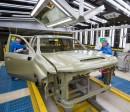The chip crunch that showed up totally out of nowhere in 2020 is still around these days, but what’s even worse is that nobody knows precisely when the whole craze is supposed to come to an end.
Industry analysts come up with all kinds of pessimistic forecasts, some of which indicate the constrained chip inventory would remain a major concern for carmakers worldwide until 2027.
In the meantime, however, chipmakers are pouring billions of dollars, sometimes backed by state incentives, into new factories and expanded capacity, obviously as they record massive demand for their products.
And this is precisely what’s silently happening right now in Japan, as the biggest chipmakers in the country are working on new production facilities specifically aimed at electric vehicles and household electrical appliances.
Toshiba is one of the companies, as a production plant for power semiconductors is projected to be built in Hyogo in a region known as the Hemeji Operations-Semiconductor complex. Toyota wants to begin the construction phase in June 2024, with the actual manufacturing to begin the next year.
Buzen Toshiba Electronics, mostly known for its ties with Toyota, is also planning similar investments, this time in photocouplers. Specifically used in battery packs that are installed in EVs and hybrids, these chips are expected to be in hot demand in the coming years, especially because of the increased focus on this type of vehicles in the automotive market.
Buzen, therefore, wants to boost the production of photocouplers by as much as 20 percent, with the new assembly lines to go live at some point in 2024.
JS Foundry, also known for its power semiconductors, doesn’t want to be late to the party, so it’s planning a new 8-inch water fabrication line as well. This time, the expanded capacity will be added to the existing lines at the Nigata facility at some point in late 2023 or early 2024. However, the company wants to see the first chips rolling off the production lines between late 2024 and early 2025.
At first glance, all these chipmakers are hoping to flood the market with new chips in 2024 and 2025, and this could be a sign that the semiconductor crisis could at least be tackled more efficiently in two or three years before eventually bringing the years-long crunch to an end.
Tech giant Intel previously warned that the constrained chip inventory would continue to be a problem for the automotive industry at least until 2024, explaining that the investments in expanded capacity would still take years to come to fruition. And as it turns out, Intel was perfectly right, as most of the new factories would only be finished and ready to begin operations in 2024 or 2025, at the earliest.
In the meantime, however, chipmakers are pouring billions of dollars, sometimes backed by state incentives, into new factories and expanded capacity, obviously as they record massive demand for their products.
And this is precisely what’s silently happening right now in Japan, as the biggest chipmakers in the country are working on new production facilities specifically aimed at electric vehicles and household electrical appliances.
Toshiba is one of the companies, as a production plant for power semiconductors is projected to be built in Hyogo in a region known as the Hemeji Operations-Semiconductor complex. Toyota wants to begin the construction phase in June 2024, with the actual manufacturing to begin the next year.
Buzen Toshiba Electronics, mostly known for its ties with Toyota, is also planning similar investments, this time in photocouplers. Specifically used in battery packs that are installed in EVs and hybrids, these chips are expected to be in hot demand in the coming years, especially because of the increased focus on this type of vehicles in the automotive market.
Buzen, therefore, wants to boost the production of photocouplers by as much as 20 percent, with the new assembly lines to go live at some point in 2024.
JS Foundry, also known for its power semiconductors, doesn’t want to be late to the party, so it’s planning a new 8-inch water fabrication line as well. This time, the expanded capacity will be added to the existing lines at the Nigata facility at some point in late 2023 or early 2024. However, the company wants to see the first chips rolling off the production lines between late 2024 and early 2025.
At first glance, all these chipmakers are hoping to flood the market with new chips in 2024 and 2025, and this could be a sign that the semiconductor crisis could at least be tackled more efficiently in two or three years before eventually bringing the years-long crunch to an end.
Tech giant Intel previously warned that the constrained chip inventory would continue to be a problem for the automotive industry at least until 2024, explaining that the investments in expanded capacity would still take years to come to fruition. And as it turns out, Intel was perfectly right, as most of the new factories would only be finished and ready to begin operations in 2024 or 2025, at the earliest.






